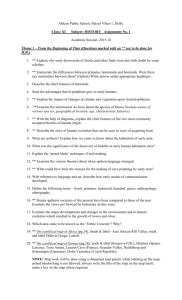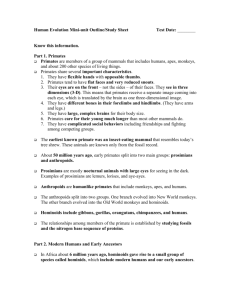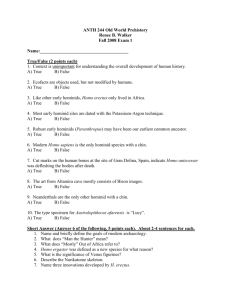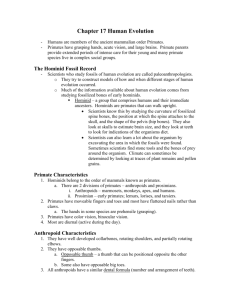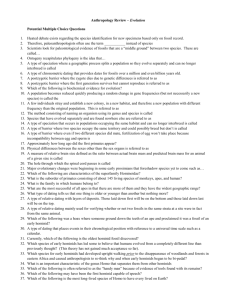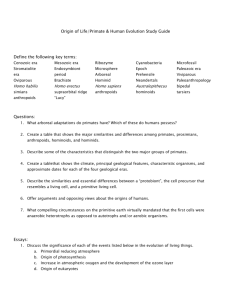Notes Chapter 17 Human Evolution
advertisement
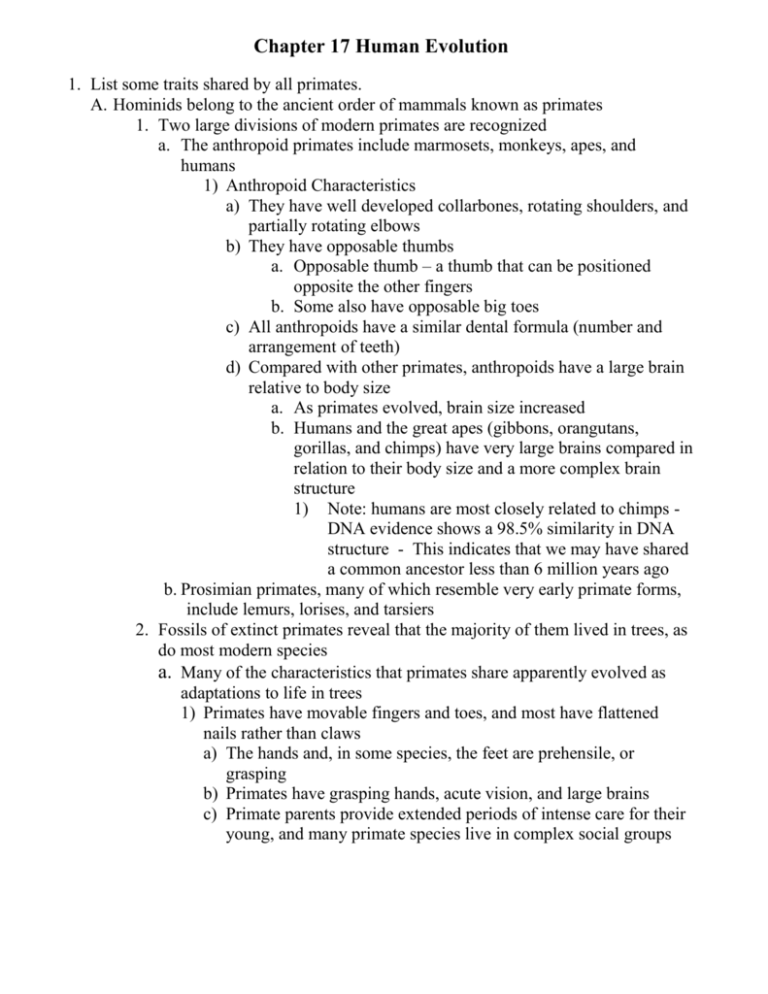
Chapter 17 Human Evolution 1. List some traits shared by all primates. A. Hominids belong to the ancient order of mammals known as primates 1. Two large divisions of modern primates are recognized a. The anthropoid primates include marmosets, monkeys, apes, and humans 1) Anthropoid Characteristics a) They have well developed collarbones, rotating shoulders, and partially rotating elbows b) They have opposable thumbs a. Opposable thumb – a thumb that can be positioned opposite the other fingers b. Some also have opposable big toes c) All anthropoids have a similar dental formula (number and arrangement of teeth) d) Compared with other primates, anthropoids have a large brain relative to body size a. As primates evolved, brain size increased b. Humans and the great apes (gibbons, orangutans, gorillas, and chimps) have very large brains compared in relation to their body size and a more complex brain structure 1) Note: humans are most closely related to chimps DNA evidence shows a 98.5% similarity in DNA structure - This indicates that we may have shared a common ancestor less than 6 million years ago b. Prosimian primates, many of which resemble very early primate forms, include lemurs, lorises, and tarsiers 2. Fossils of extinct primates reveal that the majority of them lived in trees, as do most modern species a. Many of the characteristics that primates share apparently evolved as adaptations to life in trees 1) Primates have movable fingers and toes, and most have flattened nails rather than claws a) The hands and, in some species, the feet are prehensile, or grasping b) Primates have grasping hands, acute vision, and large brains c) Primate parents provide extended periods of intense care for their young, and many primate species live in complex social groups d) Unlike most mammals, primates have color vision 1) This may have arisen when primates became more active during the day than at night, a change that occurred about 60 million years ago e) The front-facing eyes found in primates result in broadly overlapping fields of vision 1) This allows primates to perceive depth—a useful trait for an animal that moves by swinging or jumping from branch to branch in trees f) Most are diurnal (active during the day) B. The Hominid Fossil Record 1. Scientists who study fossils of human evolution are called paleoanthropologists a. They try to construct models of how and when different stages of human evolution occurred b. Much of the information available about human evolution comes from studying fossilized bones of early hominids Hominid – a group that comprises humans and their immediate ancestors - Hominids are primates that can walk upright Scientists know this by studying the curvature of fossilized spine bones, the position at which the spine attaches to the skull, and the shape of the pelvis (hip bones) - They also look at skulls to estimate brain size, and they look at teeth to look for indications of the organisms diet Scientists can also learn a lot about the organism by excavating the area in which the fossils were found Sometimes scientists find stone tools and the bones of prey around the organism - Climate can sometimes be determined by looking at traces of plant remains and pollen grains 2. Give examples of traits unique to humans. A. Bipedalism, the ability to walk primarily on two legs – walk upright 1. The cup-shaped human pelvis supports the internal organs during upright walking 2. The human spine has two curves, resulting in an S shape that allows for upright posture – chimps have a C shaped spine 3. In the human foot, the toes are much shorter than those of apes and are aligned with each other 4. Because humans are the only primates that have this foot structure, we can infer that the shape of the human foot is a specific adaptation for bipedalism B. The enlargement of the brain in humans has resulted in a more vertical face than that found in apes 1. Among other differences, the larger human brain has extensive areas devoted to the production and understanding of speech - Apes have similar areas devoted to sound making, but they don’t have “speech” as developed as ours 3. Explain how the discovery of Lucy changed hypotheses about the evolution of bipedalism. A. Modern nonhuman primates are quadrupedal (walking on all fours) - The apelike ancestors of the hominids were quadrupedal as well B. In 1974, a 3.2-million-year-old fossil of a primate was found in the Afar Valley region of eastern Africa by Donald Johanson 1. The cranial capacity, which is used as an approximation of brain size, is about equal to that of a chimpanzee (475 cm3), or about one-third that of a modern human (1,400 cm3) 2. The pelvis and leg bones, however, clearly indicated that the fossil organism was an upright-walking hominid 3. This new fossil was classified as Australopithecus afarensis, but is more commonly known as Lucy C. This find changed many ideas about the evolution of humans 1. It was generally thought that bipedalism and a large brain with areas dedicated to higher reasoning and the production of speech—had evolved at the same time 2. But the new fossil showed that upright walking had apparently come before many of these other adaptations that make the hominids unique among the anthropoid primates D. Other Australopithecines 1. A. afarensis – Cranial capacity 475 cm3 2. A. africanus – about 2.3 – 3 million years ago - Taller and heavier than Lucy - Cranial capacity 430-550 cm3 3. A. robustus and A. bosei – 1 – 2.6 million years ago - Heavier skulls and larger teeth than Lucy - Cranial capacity 450-600 cm3 4. A. anamensis – older by about 300,000 years than Lucy - A shinbone determined that the species was bipedal (?) 5. Ardipithicus ramidus – predates the earliest Australopithecines by about 200,000 years - It was also bipedal - They are still trying to find out if this species was an early relative of the Australopithecines or whether it was a species that arose and then just died out (?) 4. Name two behavioral advances made by Homo species. A. Homo habilis 1. In the early 1960s a skull was found that was larger than that of the Australopithecines - It had a cranial capacity of 600cm3 - These bones were also found among primitive stone tools - New species: Homo habilis – the “handy man” - 1.5-2.6 million years old B. Homo erectus 1. Fossils of Homo erectus (meaning “upright human”) were found as early as 1891 on the island of Java - He was the first hominid to travel out of Africa - 1.8 million – 50,000 years old - Cranial size: 700-1,250 cm3 - Height 1.7m (5 ft. 7 in.) 2. Traces of charred bones indicate that H. erectus were hunters who used fires for cooking and probably for warmth 3. To survive in the colder climates of Europe and northern Asia, many H. erectus groups lived in caves C. Homo Sapiens: 2 subgroups 1. Neanderthals: 230, 000 to 30,000 years old - Cranial size: 1,450 cm3 Height: 1.5m - They lived in caves during the last ice age and had very carefully shaped tools 2. Modern Homo sapiens: approximately 35, 000 years old - They are referred to as Cro-Magnons - Cranial size: 1,400 cm3 - Height: 1.8m a. Note: based on fossil evidence, modern humans probably coexisted with Neanderthals from about 70,000 years and with H. erectus for more than 50,000 years - As more and more modern humans arose, the other species died off from disease, or perhaps, were killed by the modern humans - Also, our tools were probably better than the tools of the other 2 groups, so we were probably more efficient hunters/gatherers, and we probably built better shelters to protect us 3. The Spread of Modern Human a. All humans belong to the genus and species, Homo sapiens b. Differences in skin color, eye color, etc., are all determined by what region of the world people live in - How did we get “all over the world? 1. Multiregional Evolution a. This hypothesis says modern humans arose from many colonies of H. erectus around the world 2. Out of Africa a. This hypothesis says that modern humans arose in Africa, and like H. erectus, left Africa - They colonized the world, replacing H. erectus and the Neanderthals Chapter 17 Human Evolution Paleoanthropologists gather data from the fossilized remains of early hominids and their ancestors. The shapes of the bone may indicate whether the organism was bipedal. Other clues may indicate diet or habits. Humans belong to the order of mammals known as primates. There are two divisions of primates: anthropoid primates and prosimian primates. Most primates have nails, instead of claws, and prehensile hands and feet. Primates have color vision and depth perception. Anthropoid primates include marmosets, monkeys, apes, and humans. Prosimian primates include lemurs, lorises, and tarsiers. Anthropoid primates have large brains relative to their body size. Bipedalism and language are two important traits found only in humans. Bipedalism is the defining characteristic for the hominids—human ancestors. The oldest known genus of hominids is Australopithecus. Its members are called australopithecines. The earliest known hominid, Australopithecus anamensis, lived more than 4 million years ago. At least two australopithecine lines, A. africanus and A. boisei, probably were not ancestral to modern humans. They became extinct more than 1 million years ago. The discovery of Lucy, a nearly half-complete fossil of an early hominid, Australopithecus afarensis, implies that hominids became bipedal before their brains began to dramatically enlarge. Ardipithecus ramidus is a recent discovery. It is not clear whether it was bipedal. Ard. ramidus is 4.4 million years old. The existence of hominid species not ancestral to modern humans implies that the hominid phylogenetic tree is bushy in appearance, with many branches representing species that died out, leaving no descendants. Early members of the genus Homo, H. habilis and H. erectus, probably were ancestral to modern humans. They had larger brains than the australopithecines and may have had speech. Our species, Homo sapiens, probably evolved about 800,000 years ago. The brains of members of the genus Homo were much larger than those of the australopithecines. Neanderthals were early Homo sapiens. They may be ancestral to modern humans, or they may have died out and been replaced by modern humans. Some anthropologists think that H. sapiens evolved in parallel from populations of H. erectus all over the world. Some anthropologists propose that H. sapiens descended from H. erectus in Africa and then dispersed across Earth. Vocabulary List A. anamensis Australopithecines Australopithecus africanus, Australopithecus boisei, Australopithecus robustus, Bipedalism Characteristics of Anthropoids Characteristics of Humans Hominids Homo erectus Homo habilis Homo Sapiens Lucy Modern Homo sapiens Multiregional hypothesis Neanderthals Opposable thumb Paleoanthropologist Pelvis Prehensile Primate Characteristics Primates Quadrupedal Recent-African-origin hypothesis
